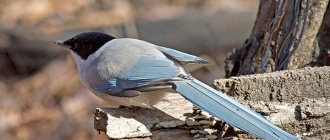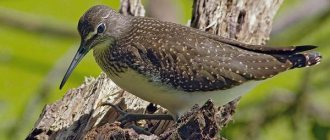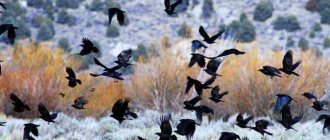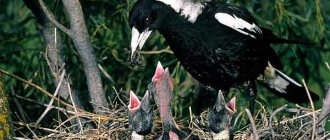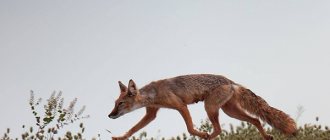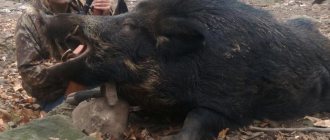Common magpie (Pica pisa) everyone knows. This is a beautiful resident bird from the Corvidae family, Magpie genus. Its length is 45 cm. The magpie has a characteristic plumage of contrasting white and black. She has a very long black tail with a greenish tint (a beautiful rudder) and black wings with a bluish tint. The head, neck, crop, back and upper chest are black. The belly, lower chest and stripes on the shoulders are white.
Magpie, photo from the site https://fondosanimales.com.es/
Magpies live in Europe, Asia, North America and North Africa. The bird often settles near a person. Often in forest parks, city parks and gardens. In large forests, magpies live less frequently. They are not seen in high mountain areas and the Far North. But in the Nordic countries there are a lot of forty.
Magpies live in small flocks or alone. During the nesting period they live in pairs. Birds willingly eat insects, lizards and mice, and drink bird eggs. Their menu includes many pests. The omnivorous magpie pecks the seeds of sunflowers, various herbs, watermelons, melons, etc.
Recently, four magpies began to fly to the feeder near our house, which always contains crumbs of bread and cereal for tits and sparrows. Magpies cannot climb into the feeder, so they are content with the crumbs that have fallen to the ground from above. These birds noisily chase each other, trying to get closer to the food. The magpies are not used to us yet, so they fly away instantly, frightened by any movement. Therefore, they are difficult to photograph.
The flight of forty is considered difficult. They flap their wings frequently and usually fly in a straight line. When a magpie is on the ground, it walks or jumps.
In the East of Russia, East Asia and the Iberian Peninsula lives the smaller (length 34 cm) blue magpie (Cyanopica cyanus) with bluish wings. Some authors distinguish the Siberian blue magpie (living in Siberia) and the Spanish blue magpie (from Spain). A significant part of ornithologists combine these beautiful birds into a single species.
In addition to these species, there is also the Chinese azure magpie (Eastern China), the red-billed azure magpie (Himalayas - Nepal) and the green magpie (Himalayas, Indochina, Malaysia).
Magpies from the subfamily Long-tailed Magpie . In India, China and the Himalayas there are wandering (English) magpies , which are classified as forest magpies (Bram).
Kinds
— Advertising —
The genus Soroki includes three species:
Pica hudsonia - American magpie
An American magpie walks through the grass
Appearance: body length – up to 50 centimeters, wingspan – 90 centimeters. Externally identical to the Common Magpie.
Distribution: Found in the USA and Mexico.
— Advertising —
Features: feeds on rodents and cacti. The nest builds without a roof. The bird is semantically related to the Californian magpie and forms a single subgenus with it.
Pica nuttalli - California magpie
California magpie resting on a branch
Appearance: black and white plumage, yellow beak and eye ring.
Distribution: The magpie lives in the California valley, hills and mountains.
Features: California magpie is susceptible to viral diseases. 15 years ago, West Nile virus killed half of the entire population.
Pica pica - common magpie or European magpie
The European Magpie looks thoughtfully into the distance.
Appearance: a bird with traditional black and white plumage.
Distribution: the common magpie inhabits Europe and Russia, excluding the northeastern regions.
Features: the magpie is a typical representative of the bird family, inhabiting the cities and villages of Russia.
The whole truth about magpies
Photo copyright: robin24 CC by 2.0
Indeed, magpies sometimes look quite sinister
The reputation of a magpie is beyond envy.
Pica pica is usually accused of wrecking .
But is the reputation true? BBC Earth
correspondent decided to look into this So.
Myth:
Magpies are known for their thieving habits: they are greedy for shiny objects, which they use to decorate their nests. In addition, magpies eat the eggs and defenseless chicks of songbirds, which is why the populations of many birds are declining.
Reality
:
Magpies are not thieves, they are just curious. These birds show interest in various objects, but do not give preference to shiny things. Oroks are indeed voracious hunters of songbirds, but there is no strong evidence that this has any effect on the number of the latter.
In 1815, two French playwrights - Louis Charles Quenier and Jean Marie Theodore Baudouin d'Aubigny - wrote a historical melodrama called "The Thieving Magpie, or the Maid of Palaiseau", in which a maid is sentenced to death on charges of stealing silverware from her master. , while in fact the thief is his pet - the magpie bird.
Subsequently, the Italian composer Gioachino Rossini used this plot in his opera “The Thieving Magpie, or the Danger of Judging by Appearance.” And in the eyes of the public, the magpie remained for a long time a bird with thieving habits.
Chicks leave their nest only when they are one month old.
Appearance
Photo of a magpie on a stump
The magpie has a slender, elongated body; long fan-shaped tail; short, narrow, pointed at the end wings; small head and thick, curved beak. The paws are long, four-toed, the fourth toe points backward, which allows the bird to cling tightly to branches and maintain a stable position.
Magpie walks on green grass
The plumage of the magpie is two-colored: the head, neck, chest and back are blue-black. Violet and green shades are noticeable in the sun. The long tail is black. The belly and shoulders are white. Sometimes the wings along the border are also painted white. The eyes are black, the beak is dark gray, the legs are gray-brown.
The color of young birds also contains white and black, but the plumage is not as bright and contrasting as that of adult magpies. In spring, birds begin to molt. At this time, magpies look faded, some of the feathers fall out and patches of skin are visible here and there. By the beginning of summer, birds grow new dense matte feathers of rich, uniform color.
Photo of a magpie on a stone
The plumage of magpies of both sexes is identical, so it is almost impossible to distinguish a female magpie from a male. However, there are differences in size between birds: the male magpie is one and a half times larger than the female.
The chicks grow up and learn to fly
Magpies, which people took as chicks and raised in their homes, become tame. They fly away for a short time, after which they return each time. Forty is taught various funny tricks and how to pronounce words.
Young birds are very active. According to Konrad Lorenz, they will never allow a cat to catch them. Magpies instantly react to the appearance of any threat.
Gerald Durrell describes the growth of his two birds, who were nicknamed Magpies in the house.
By the time the grown chicks were covered in feathers, Larry had become so accustomed to them that he had completely forgotten about their supposed criminal tendencies. Fat, smooth, talkative Magpies sat on the edge of their basket and expressed innocence with their whole appearance. Everything went well until they started learning to fly. In the first stages of training, Magpies simply jumped off the table on the veranda and, desperately flapping their wings, flew through the air for about fifteen feet, and then plopped down on the stone tiles. Their courage grew along with the strength of their wings, and soon they were able to make their first real flight, flying around the house. Their view was simply wonderful. Long tails sparkled in the sun, wings whistling through the air as the birds swooped down, flying over the vines.
What do magpies eat?
Magpie flies with prey in its beak
Magpies feed on food of animal origin. They are indiscriminate in their food and feed on all the small animals that come their way. In spring, magpies feed on caterpillars, worms, and beetle larvae; in summer - all kinds of insects; In winter, magpies feed on food waste. When there is a shortage of food, birds eat cereal seeds, bread crumbs, sunflower seeds, and the fruits of various trees. Adult magpies sometimes hunt small rodents and lizards. They kill their victims with a blow from their powerful beak.
Magpies are known predators of other people's nests. Where the magpie family lives, other small birds usually do not live, since the magpies simply eat them. In spring and early summer, magpies plunder the nests of passerines and waterfowl. They feast on the eggs and chicks of sparrows, ducks, coots, quails and partridges.
Two magpies are eating on a tree branch
Magpies cause a lot of trouble to rural residents. In search of food, birds fly to farmyards and attack chickens and ducklings. Magpies often steal chicken eggs. It is extremely difficult to catch magpies stealing, since these birds behave only in cases where they are not in danger. Magpies steal eggs from the chicken coop while the chickens are feeding. In a few minutes, forty manages to crack a chicken egg and drink it right “at the crime scene.” Many farmers ask the question: “what to do if a magpie steals eggs?” Birds can be scared away from the yard by a stuffed animal in the form of a person or all kinds of rattles and scarecrows (magpies are afraid of noise).
Magpie is a smart bird. When full, she will not throw away the remaining food, but will hide it in a secluded place. In case of hunger, she will remember her reserves. The bird never forgets about its hiding places; its intelligence allows it to quickly find hidden food.
Magpies eat grains
At home, magpies eat leftover human food, chicken and beef, fish, vegetables and fruits. Magpie chicks feed on worm and beetle larvae, small caterpillars, flies and grasshoppers.
Why was the bird called magpie?
Magpie on an iron fence
Magpie was named so for the sounds this bird makes. In the ancient Slavic dictionary, the word “welding” was used to define this bird, a derivative of “sverchati” - that is, “cricket” or “cricket”. As you know, the magpie makes a characteristic chirping sound - “chirping”.
Magpies are capable of onomatopoeia
The magpie's voice is clear and sharp. The call is a loud chirping sound. Chirping, various extraneous sounds and even screeching are woven into the song.
Magpies raised by humans are gullible and importunate. This intelligent bird is very sociable. Bram describes a case where a large macaw parrot could not learn to speak for several months until its cage was placed next to the cage of a tame magpie, which did not shut up for days. At first, the macaw began to imitate the chattering magpie, then he was able to pronounce individual words, learned new ones and called his master’s children by name.
Darrell's Magpies also learned to reproduce different sounds.
Confined to one place, the Magpies could now devote a lot of time to their studies, which consisted of a solid mastery of Greek and English and skillful reproduction of natural sounds. In a very short time they learned to call all members of our family by name and played Spiro with exceptional cunning. After waiting for him to get into the car and drive a little away from the house, the Magpies would rush to the corner of the cage and shout: “Spiro... Spiro... Spiro!...”, forcing him to hit the brakes and turn back to find out who was calling him. The words “Go away!” brought them much innocent joy. and “Come here!”, which they shouted alternately in Greek and English, to the utter confusion of the dogs. Another trick that amused them endlessly was the deception of the poor, unfortunate chickens, who spent their days rummaging in the ground among the olive groves. From time to time, a maid appeared on the threshold of the kitchen and began to make squeaking sounds interspersed with some strange loud hiccups. This was the feeding signal, and as if by magic, all the chickens were at the kitchen door. As soon as the Magpies mastered this call, they completely tormented the poor chickens.
Spreading
Area
Photo of a magpie in nature
Magpies live in Eurasia, Africa, and North America. Most of the population is concentrated in Europe and Central Asia. Birds do not live in the north of the continent. Many magpie families live in Greece and the islands of the Mediterranean Sea. Magpies also inhabit some areas of North Africa - the coastal areas of Algeria, Tunisia, and Morocco. In America, these birds live in the western part - in California, Oregon and Alaska. In Canada, magpies are found in British Columbia.
Habitats
A magpie and a sparrow are sitting on an iron railing.
Magpies nest in open areas rich in small animals. Birds choose forest plantations or the outskirts of bush thickets to live. These birds are rare in large forests. Magpies settle near villages and cities, some inhabit city parks and squares. In winter, magpies live near human habitation, as this makes it easier to find food.
Behavior in nature
This is a very active, restless bird that can fly a considerable distance in search of food. Doesn't hesitate to destroy other people's nests. She avoids people because she is very careful. She is known for her amazing intellectual abilities: she can recognize her own reflection in the mirror and people’s faces.
Where does he live?
Magpies are often found in gardens and parks. They are widespread in Russia, Asia, Europe, northern Africa and North America. It prefers open spaces, but when threatened, it can hide in dense forest thickets.
Diet and food
They are omnivores and can eat both plant and animal food. Insects, small rodents, bird eggs, fruits, fruits, berries - this is what the magpie eats.
Beautiful birds can cause serious harm, destroying vegetable gardens and fields.
Features of hatching chicks
Birds often form strong pairs for life, build excellent nests, and both partners do this work. The magpie's nest is most often of impressive size and is equipped with a “roof” of dry twigs for protection from precipitation.
Note! The main material used for construction is grass and branches; the structure is coated with clay on top, making it very durable.
Egg laying begins at the end of April - the first days of May. The clutch includes 8 eggs, only the female does the incubation, the babies are born after 18 days.
The chicks stay with their parents for up to a month, feeding them insects and later small birds.
Looking at magpie chicks, it is difficult to imagine that in a couple of months they will turn into beautiful black and white birds.
Wintering or migratory
Many people are interested in whether the magpie is a wintering or migratory bird. This bird does not migrate, preferring to winter in its main habitat. However, those birds that live in northern latitudes can fly to warmer regions for the winter and return to their place in the spring.
Voice of the Magpie
Magpie calls
When communicating with each other, magpies use chirping sounds consisting of a series of syllables “chuck-kak-shak” or “shack-shack-shack”. The loud voice of a magpie is a warning signal. If the tempo of the chirping is fast and sharp, it means that danger is looming over the flock of birds. Hearing the warning cry, the birds fly away. A prolonged cry means that there may be a predatory animal nearby and the birds need to be on alert. The magpie's voice is ringing, hoarse and loud.
During the mating season, magpies use various intonations and sound forms in conversations with their fellows. So, for example, to indicate territory, the magpie calls “kia-kia” or “kick-kick.” Protecting the nest from uninvited guests, the magpie loudly shouts “chakr-chakr”, “chikr-chikr” or “chara-chara”.
Magpie on the edge of a stone
To attract a partner, the bird makes quiet melodic sounds in different tones. Rhythmic singing can become arrhythmic, a low timbre is replaced by a high one, a soft trill alternates with abrupt menacing exclamations.
Chicks demanding food squeal in a shrill voice “pirr-pirr”. Young birds that have already separated from their parents are characterized by their own singing. When communicating with adult birds, they use two-syllable calls “yshiyak”, “chyuk” or “chew-yok”.
Magpie is a migratory or wintering bird
A magpie took off from a tree branch
. Magpies are not migratory birds. They never fly away from the nesting site for a long time. In the autumn, wintering magpie birds gather in flocks and fly to the outskirts of cities and villages, as it is easier to find food there.
Magpie in flight
Despite the fact that magpies are sedentary birds, they still make periodic migrations within the perimeter of their habitat. As the sun sets, magpies living in the same area fly to a common roost. Magpies wait out the night in large flocks in windless, secluded bush thickets near water bodies. Neighboring birds gather for a mass roost in the same place during the autumn-winter period. Some of them fly to their “apartment” many kilometers from their permanent place of residence. Daily migrations stop in the spring, with the onset of the nesting period.
Nutrition
The basis of food for magpies in spring and summer is animal food (from the smallest insects to fish washed ashore). They can even steal the smallest ones from a bucket from a gaping fisherman. In winter, the magpie eats everything that is edible, and does not even disdain the contents of boxes intended for garbage.
The magpie is a useful bird that destroys numerous pests and small rodents in the fields. But she also has a negative quality that is harmful to humans: she often steals chicks and eggs on farms.
Lifestyle
Magpie near the feeder
Magpies prefer to live separately from their relatives. Sometimes the birds gather in groups of 6-8 birds, but this does not last long - until the young animals mature up to a year and separate from the family. The rest of the time, magpies live in pairs. Bird nests are placed at a distance of 100-300 meters from each other. Such close proximity allows birds to promptly warn each other about danger.
Lonely magpie on a branch
Magpies move across the surface not in steps, but in jumps. They jump on both legs at once. When moving, the bird's tail is raised up. The birds take off from their place. The flight of the magpie is smooth and maneuverable. During the flight, the bird opens its wings, straightens its tail, points its head forward, and bends its paws. In the air, the bird prefers to glide; its flight speed is 35-40 kilometers per hour.
It is known that magpies are cunning, dexterous and agile birds. If there is not enough food, then the birds look for food in vegetable gardens and farmyards.
Photo of a magpie high on a tree
Birds can easily outwit a pet and steal something edible from its bowl. Sometimes birds forage for food in groups of 2-3 birds. While two magpies are distracting a chicken or a dog, the third one is feeding. Then the roles change.
Magpies are curious, but at the same time cautious, prudent birds. It has been noticed that these birds are able to build logical chains, remember information, and easily avoid traps. Birds do not openly steal: they first make sure that nothing threatens them, and only then they grab the thing or food they like and immediately fly away.
Pensive Magpie
Magpies are known for their passion for shiny things. These birds drag candy wrappers, sparkles, pebbles and glass sparkling in the sun into the nest. Ornithologists cannot say what motivates these birds in such collecting. But one thing is clear: the magpie’s ability to collect everything shiny formed the basis for the phrase “like a magpie,” that is, “a person who loves everything shiny - like a magpie.” True, experiments in recent years have made it possible to doubt that the magpie deliberately chooses only shiny objects. Researchers say that if a magpie is offered a choice of things, including one that is shiny, the bird will not always choose that one.
Reproduction
Female and male magpies
At the end of February, magpies begin their breeding season. Magpies gather at old nests and begin repairs. If the nest is severely destroyed, the magpies build a new one, but in a different place.
Nest
In the photo - magpies make nests
Magpies make nests on thin trees or bushes at a height of 3-6 meters on the ground. Despite the fact that the bird's nest seems accessible, predatory animals cannot reach it due to the fragile support on which the magpie's house rests.
A magpie's nest is a complex architectural structure. Unlike the nests of other birds, the magpie's has a roof. From a distance, the dwelling looks like a large ball assembled from dry branches. The frame of a magpie's nest is built from strong rods intertwined with each other. The roof of the bird is made from thin and flexible branches.
Photo of magpie eggs in a nest
The entrance is located in the side wall. The bottom of the bird's nest is smeared with clay or damp earth - such material will make the home even stronger. On top of the dried earthen floor there is a layer of leaves, thin young branches and roots. The female lays eggs on top of the woody layer.
Magpie chicks
Small magpie chicks
The female magpie lays 6-8 eggs. Magpie eggs look small, the shell is greenish with a brown spot. Incubation is done exclusively by the female. After 18-20 days, tiny naked chicks are born. Both parents are involved in heating and feeding the young. Adult birds take turns bringing worms and caterpillars to the hungry chicks. In the first days of life, the cubs have an increased appetite, so the chicks constantly demand food, squealing around the area. By the age of one month, the chicks have grown enough to look for food on their own. At this time, the magpies already master the technique of flight, but continue to stay close to their parents for at least another two months. By the following spring, the young birds separate from their parents and start a family.
Nest construction
How do magpies build a nest? They make the base of the nest (frame) from long and thick dry branches. Then, on such a fairly massive foundation, they build a bowl made of earth or clay. Moreover, the latter is reinforced with thin birch branches. Then, the inside of the tray is lined with thin branches of willow, birch and the roots of some plants, and something like a roof is built over the nest itself, representing a loose, rather chaotically folded canopy of larger dry branches. The latter construction significantly increases the size of the nest. With such a wonderful canopy there is no escape from the rain, but the clutch and chicks can be perfectly protected from various feathered predators.
The magpie's nest (photo shown above) is a fairly intelligently built structure.
Magpie at home
A man holds a magpie in his hand and feeds it.
A wild bird like a magpie can become a pet. These birds quickly get used to humans and adapt to the surrounding conditions. Fed by humans, adult magpies recognize their owner by sight, become tame, feed from hands and do not fly away from him for long.
Magpie chicks at home
You can only tame a magpie that fell into human hands as a chick. Magpie cubs are easy to feed, as these birds are omnivores. Homemade food is suitable as food - fish and meat, bread, fruits and vegetables, berries and nuts. In order not to harm the fragile body, it is better to give food raw, without using any spices. Two-week-old chicks eat up to ten times a day, menstruation - three to four times. You need to feed the magpie in small pieces. Sometimes you can give cottage cheese and eggs. It is strictly forbidden to give poultry pork and white bread. Poultry needs vitamins, especially in the autumn-winter period.
An impudent magpie tries to steal food from a child
Magpies love to take a bath - by bathing, the birds cleanse their feathers and skin of parasites. This must be remembered when arranging an enclosure or cage for your pet. By the way, many magpie keepers do not limit the life of birds to a cage and allow their pets to move freely around the house. However, according to the observations of zoologists, the bird feels more comfortable in a cage and behaves calmer than when it lives in an open space.
Interesting Facts
Photo of a magpie looking into the distance
- Magpie - able to recognize herself in the mirror.
- The entrance to the magpie's nest faces south to keep the home warmer.
- The magpie builds up to 8 nests, and then chooses the best one from them.
- Extra nests are needed to distract predators.
- In the Middle Ages, church ministers believed that magpies personified evil spirits. In the 14th century, Metropolitan Alexei even forbade birds from flying into the city for this reason.
- In China, the magpie is revered and considered the bird of happiness.
- In Rus' it was customary to call talkative women magpies.
What are male magpies called?
A male magpie has found food for himself.
Like most wild birds, the “magpie” has a single name without distinguishing between female and male. Therefore, to indicate gender in Russian, the phrases “female magpie” and “male magpie” are used.
The magpie chick is called “magpie”, and in the plural – “magpie”.
Signs associated with magpies
Photo of a magpie soaring in the sky
The image of a magpie is found in the cultures of many nations. For some, this bird represents happiness, wealth and success, for others it is a harbinger of bad news and trouble.
The magpie gained notoriety back in the days of Noah's Ark, when the bird did not fly onto the ship with all the other animals, but remained on the roof. The bird showed a complex character, not obeying other people's rules. The magpie is credited with negative qualities - a thief, a liar, a chatterbox. Many sayings are associated with this black and white bird.
Beautiful magpie among green grass
This is how gossipers are called “cracking like a magpie,” and when talking about where a person learned about some news, they say “a magpie brought it on its tail.”
Despite the numerous unpleasant characteristics, most of the signs associated with the appearance of these birds still have a positive context.
- A bird flew onto the balcony - a sign that does not bode well. The house will be calm, no scandals or quarrels.
- A magpie flew into the house and chirped - good news awaits the family.
- A magpie flew into the yard or settled in the garden - the owners will face financial difficulties.
- A magpie circling over the house is a sign that signifies the onset of a dark streak in life.
- A magpie sat on the window, it jumps and chirps - a person will find himself in the center of gossip and intrigue.
- Two magpies are sitting in front of the house - guests should be expected.
- A flock of magpies flying overhead foreshadows a wedding.
- It is a bad omen if a bird knocks on the window - it brought bad news, perhaps one of the relatives will die soon.
- The magpie knocked on the window and flew away - a sign promising that all adversity will bypass the house.
